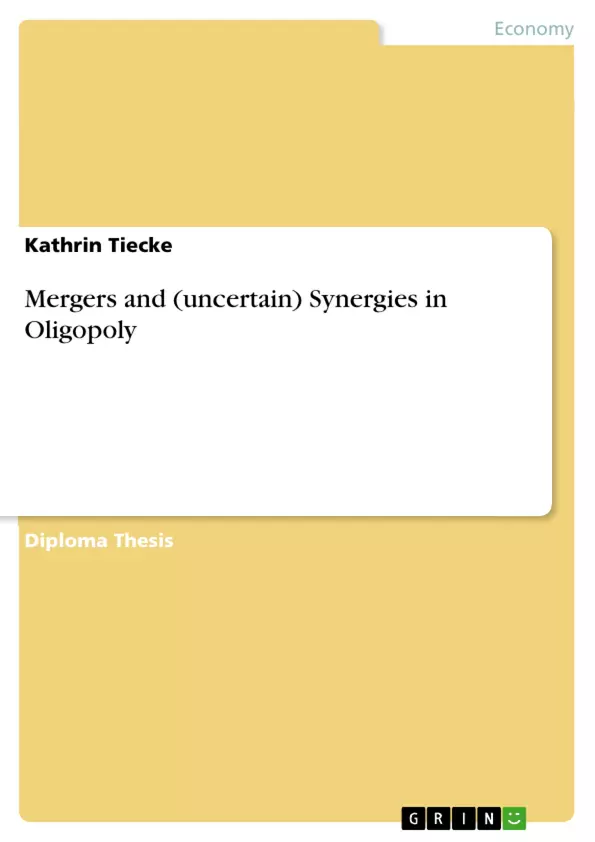...Farell and Shapiro state that there is no necessity for mergers as cooperation and coordination can be achieved at an equivalent level via contracts: “..., modern economic theory observes that virtually anything that can be done with a merger can in principle be done instead with some kind of contract, perhaps a very complex (or restrictive) one.” (Farrell and Shapiro
2001, p. 691)...
6.2 Concluding Remarks
...In the last section I introduce the strand of economic literature that deals with the process of mergers under uncertain efficiency gains. By introducing uncertain synergies to Cournot merger models the merger paradox can be solved in all above presented approaches and compared to the deterministic models there is a wider scope of profitable mergers. The informational asymmetry after the merger benefits the merger members although efficiency gains may be not obtained post merger. Thus mergers are more likely to be beneficial compared to the case where uncertain efficiency gains are not assumed. It has been shown that the incentives to merger coincide with the degree of uncertainty and when firms are aware of this uncertainty they are able to prepare for the post-merger integration
process much better since post-merger actions can be specified more accurately. Any merger with uncertain synergies that needs to be approved by competition agencies can positively affect the approval by evaluating the uncertain efficiency gains with the required post-merger process...
...this may be an attempt to replicate the merger failures in the real world. To analyze further the role of uncertain synergies, models that depart from the one-shut nature should be implemented. This might give insights why merger formations appear wavelike and if the equilibrium changes when non-merged firms adjust as soon as
they observe the true type of their (new) rival. As the world has become realistically more transparent the unmerged firms may observe rather fast whether they face a more or less efficient rival and so the time horizon should ex ante alter the expected profits of the market players compared to the one-shot nature of the standard Cournot game.
The question what types of firms, the most or the least efficient ones are involved in a merger remains unanswered as there are ambiguous results in the theory of endogenous merger formation. The empirical observations also do not support the theory that low-performing firms are the preferred target for acquisitions.
Inhaltsverzeichnis (Table of Contents)
- Introduction
- Literature Review
- Industry Structure and it‘s Implications on Competition
- The Static approach of Industry Structure
- Monopoly
- Cournot Competition
- Bertrand Competition
- Horizontal Mergers and the Effects on Quantities and Prices
- The Effect of a Merger within Bertrand competition
- Incentives for a Merger within Bertrand competition
- Complementary Goods
- Incentives to join a Merger
- The Effect of a Merger within Cournot competition
- Incentives for Mergers within Stackelberg games - Solving the Merger Paradox
- Incentives for Mergers - Solving the Merger Paradox
- The Effect of a Merger within Cournot competition on Welfare
- Horizontal Mergers and Synergies
- Efficiency Gains
- Economies of Scale
- Economies of Scope
- A critical view towards Synergies
- Endogenous Mergers and Efficiency Gains
- Horizontal Mergers and uncertain Synergies
- Modeling Mergers and uncertain Synergies
- The Bayesian Equilibrium
- Merger with Uncertainty and the Impact of private Information
- The Effects of Uncertainty within Bertrand competition on Welfare
Zielsetzung und Themenschwerpunkte (Objectives and Key Themes)
This thesis aims to analyze the economic literature on merger formation, focusing on the effects of mergers within Cournot and Bertrand oligopoly models, including deterministic and uncertain scenarios. It seeks to understand the incentives for firms to merge, the consequences for market structure, and the impact on welfare.
- Profitability of mergers under different competitive structures
- The merger paradox and attempts to overcome its puzzling results
- The role of efficiency gains and synergies in merger formation
- The impact of uncertain cost savings and the informational advantage of merging firms
- The implications of uncertainty for antitrust policy and welfare
Zusammenfassung der Kapitel (Chapter Summaries)
The thesis begins by reviewing the theoretical frameworks of Cournot and Bertrand competition, highlighting the key differences in strategic behavior and market outcomes. It then explores the effects of mergers on quantities and prices, analyzing the incentives for mergers in both Bertrand and Cournot settings. The merger paradox, which suggests that mergers are generally unprofitable in Cournot competition, is discussed, and various solutions are presented. Chapter 4 focuses on efficiency gains and synergies, examining the role of economies of scale and scope in merger formation and the debate surrounding the definition of synergy. Finally, Chapter 5 explores the impact of uncertainty on merger outcomes, examining models that incorporate private information and uncertain cost savings.
Schlüsselwörter (Keywords)
The thesis focuses on horizontal mergers, oligopoly, Cournot competition, Bertrand competition, merger paradox, efficiency gains, synergies, economies of scale, economies of scope, uncertain efficiency gains, private information, Bayesian equilibrium, and antitrust policy.
- Quote paper
- Kathrin Tiecke (Author), 2011, Mergers and (uncertain) Synergies in Oligopoly, Munich, GRIN Verlag, https://www.grin.com/document/172820



